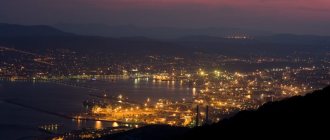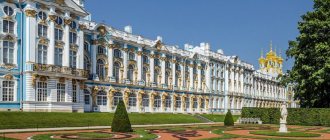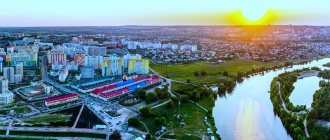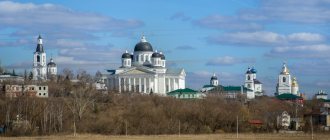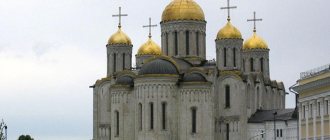It’s worth coming to the Penza region to see with your own eyes the land that has given the world so many extraordinary personalities. Penza is proud of writers V.G. Belinsky, M.Yu. Lermontov, D.V. Davydov, composer A.A. Arkhangelsky, directed by V. Meyerhold. The famous silent film actor I. I. Mozzhukhin was born and raised in the city. Penza land is the birthplace of the great historian V. O. Klyuchevsky, author of the “Course of Russian History”.
Penza, at first glance, a quiet provincial town, even bore the sonorous name “New Athens”, second only to capital cities in terms of its level of education.
Many phenomena of cultural life took place for the first time in Penza. The city is the birthplace of the Russian circus. In 1873, a performance took place presented by Russian entrepreneurs - the Nikitin brothers.
The geographical location of the region is also extraordinary. It is located in the center of the European part of Russia, at the junction of three natural zones: forest, steppe and forest-steppe.
Cities and villages
Penza
Penza began as a defensive fortress, built to protect the borders of the Moscow principality. At the beginning of the 19th century it was already a large city, the center of the province.
Below we will briefly go through the main Penza places, but if you are planning to visit this city, read the overview of all its important attractions.
Modern Penza has not broken away from its past. The city has preserved merchant districts. Even the fact that Penza bears the title of the greenest city in the Volga region has historical reasons. It all began with a visit to the city by Emperor Alexander II, who, having examined the memorial sites and discovered ruins and desolation on the site of the fortress, was very dissatisfied and proposed to create a park. Today this is Lermontovsky Square, it begins the central street of Penza - Moskovskaya, Penza Arbat.
- Monument to the First Settler. It was unusual for 1980 to unveil a monument not to a politician or a major military leader, but to the First Settler - the one who defended his native land and developed it in peacetime. The sculptural composition is dedicated to the 600th anniversary of the Battle of Kulikovo.
- "Sprout". On the Sura embankment there is a 25-meter-high monument to Glory, popularly known as “Rostock”. It symbolizes the development of the city and the country. Nearby is the Druzhba suspension bridge - the best engineering structure of the Soviet era.
- Traffic light tree. There is a traffic light tree in the park opposite the train station. This art object consists of 36 old traffic lights that have spent their time on the city streets. As darkness falls, the traffic lights turn on and change colors to the beat of the music. The idea for this installation belongs to the former mayor of the city, Roman Chernov, who saw a similar tree in London.
- "Mug of beer". Moskovskaya Street leads to Fontannaya Square, notable for its light-and-music fountain and a reproduction of Manet’s painting “A Mug of Beer.” This impressive mosaic was made from 55 thousand beer caps and installed in 2000.
- "Cuckoo". Near Fontannaya Square, in a small park, there is a tower cuckoo clock, as a monument to the wall clocks common in houses of the last century. This public garden in the city is a place for friendly meetings and romantic dates.
Museums of Penza
- Museum of one painting named after G. V. Myasnikov. The museum building itself is a 19th-century monument, the former home of a police chief. The museum does not have permanent large exhibitions. One painting at a time is exhibited there. Its screening is preceded by a film or story about the author of the work. There are no such museums in our country anymore.
- Museum of Performing Arts named after V.E. Meyerhold. The museum was opened in 1984 and became the first memorial monument to Meyerhold in Russia and abroad. The opening of the museum coincided with the 110th anniversary of the director's birth. The Meyerhold family lived in the building until 1898. The museum is also interesting because of the existence of the dramatic “Theatre of Doctor Dapertutto”. Performances are performed in a small hall, a former living room. The artists are a meter away from the audience. All eight theater actors are men. They play female roles and act as stage workers. All theatrical productions develop Meyerhold's ideas.
- Museum of Folk Art. The museum is located in the estate of the Penza timber merchant S.L. Tyurin. The estate is a real carved mansion, which contains objects of folk art: carved wooden vases, straw dolls, products made of wicker, Abashevo whistles.
- Museum of V. O. Klyuchevsky. Opened in 1991. Consists of two wooden houses. The museum's exhibitions tell about the Penza period of the historian's life and about his scientific and social activities.
- The meat passage is an architectural monument. It is already over 100 years old. At first there were shopping arcades there, then they wanted to turn the passage into an art gallery, but the dampness of the basements let them down. Now there are sports clubs there.
Kuznetsk
It will be interesting as an example of a county town of the 19th century. It is worth taking a walk through the historical part of the city, where buildings in the Russian classicism style have been preserved.
- Ascension Cathedral. The wooden church was built in 1699. The cathedral became a stone one in 1856. With the help of believers, after the Soviet decline, the temple was revived. Today, divine services are held here, there is a Sunday school, classes in icon painting, and Orthodox books are stored.
- Church of the Kazan Icon of the Mother of God. It is notable for the fact that during Soviet times it was not destroyed and was not even closed. Built in the “Russian” style. The temple is interesting with its bell tower in the form of a three-tiered tent.
- Chapel of St. Paraskeva the Martyr. It stands on the site of the believers’ vision of the icon of the holy martyr Paraskeva. Local merchants provided funds for the construction of the chapel. Now there is an equipped approach to the source, you can get holy water and take a dip in the bath.
It is worth mentioning one more attraction of Kuznetsk. In the park near the city administration there is a taganaite stone brought from the Urals. The townspeople call it the stone of sun and love.
Nikolsk
The city was previously called Nikolo-Pestrovka. In the mid-18th century, the village was merged with the settlement of Malaya Pestrovka. This is how a new city was formed. The crystal factory brought Nikolsk worldwide fame.
- Museum of Glass and Crystal. The collection was founded in 1789. Recognized by art critics as the best collection of glass in Russia. The collection began as a model room at the Nikolsko-Bakhmetevsky plant. Three generations of the Bakhmetev family collected samples created by the craftsmen of their factory, products of Bohemian and French craftsmen. During Soviet times. The collection continued to be replenished through the efforts of the plant’s directors, and now thanks to private individuals.
- Kazan Church. Built in the Byzantine style, it has an unusual wooden bell tower.
- Museum of the writer A. Ya. Yashin. The exhibition on the first floor is dedicated to military history. Stuffed animals and elements of fairy tales are also presented. The second floor of the museum presents the preserved interior of the 19th and 20th centuries. The museum also has a numismatic collection.
The city has a cable-stayed pedestrian bridge across the Yug River. Just out of curiosity, you can try walking along it.
Lermontovo
The village belongs to the so-called Lermontov places. In the village, which was formerly called Tarkhany, there was the estate of the poet’s grandmother Elizaveta Arsenyeva.
State Lermontov Museum-Reserve "Tarkhany"
Address: Belinsky district, Lermontovo village, Bugor street 1/1 Telephone: Website: www.tarhany.ru Opening hours: 09:00 – 16:00 Mon-Sun, Tue – day off Cost: 100 rubles
M. Yu. Lermontov spent his childhood in Tarkhany. The poet’s ashes, brought from Pyatigorsk, are buried here.
The museum complex conducts regular excursions, organizes exhibitions and theatrical performances. You can see the estate itself, furniture, utensils of that time, and Lermontov’s personal belongings. There is even a real working windmill.
Kamenka
The birthplace of the surgeon, academician N.N. Burdenko, poets M.I. Kirillov and M.A. Feldman. Seventeen Heroes of the Soviet Union were raised by little Kamenka.
In the town you can see the estate of Count Voyenkov, intended for Tsarevich Alexei. The development of Kamenka is associated with the name of Voyenkov. Through the efforts of the count, a railway passed through the city.
Voyenkov was involved in the development and distribution of Kuvaki mineral water from a local source. Water was believed to have a beneficial effect on Tsarevich Alexei.
Today, water is still being extracted, and the estate is falling into disrepair.
The road from Penza to Nikolsk always goes through beautiful forests. The few settlements that you encounter along the way are completely historical places - the former estates of the Shuvalovs, Golitsins, Oblenskys. And here is Nikolsk itself. The city is comfortably located on both banks of the river. Vyrgan (basin of the Inza and Sura rivers). It arose from two villages: Nikolskoye (Nikolo-Pestrovka), known since 1668, and Pestrovka (Malaya Pestrovka), founded in the 1680s. In 1761, both villages ended up in the hands of one owner, Alexei Ivanovich Bakhmetyev.
Alexey Ivanovich Bakhmetyev - being an energetic man, started a canvas factory and a distillery on his estate, in the village of Nikolskoye. But these productions did not satisfy him. Alexey Ivanovich decided to build a glass factory. After all, the village is surrounded on all four sides by pine forests, which was important for glass production in the 17th century. Because wood is fuel, and to melt glass you need a temperature of 1000 degrees! So the forest was treated with care here so that it would last for a long time, otherwise, why start a business? Then Bakhmetyev turned to Catherine II with a request to allow him to found such a plant. On August 3, 1763, by decree of Empress Catherine II, permission was received from the Manufacture College in his name “to establish and allow the kindest craftsmen to make crystal and glassware.” Capital A.I. Bakhmetyev, invested in the business, amounted to three thousand rubles. Alexey Ivanovich from Europe, with great care, transports French and Bohemian glass off-road. For the first time in his life, Nikolsky’s peasant was allowed to reach out and touch the outlandish items of lordly luxury. Yes, and find out that the components of glass: chalk, soda, arsenic, sand... And if you add 18 - 24% lead oxide to them, it will acquire heaviness and iridescence, transparency and sonority... Because at a temperature of 14,000 it will turn into crystal. Hundreds of samples of dishes, lamps, perfume accessories, elements of church decoration and utensils were produced here. However, after the Pugachev riot of 1775, all enterprises were destroyed and burned to the ground. Bakhmetyev turned to the state for help, which was provided to him, and over time, Alexey Ivanovich established his business. He turned out to be a very enterprising owner. A.I. died Bakhmetyev in 1779, but the order he established was preserved under the widow Agathoclea Ivanovna.
Bakhmetyev's widow, Agrafokleya Ivanovna, managed to increase production. There were already three crystal and glass factories in operation, where they produced: sheet glass, damasks, bottles and various dishes for a total amount of forty thousand rubles a year. They traded in Moscow and at the Makaryevskaya Fair. The most expensive were decanters at seventy kopecks apiece and crystal wine glasses at fifty kopecks. The factories employed 184 workers and two caretakers.
Nikolai Alekseevich Bakhmetyev, who continued his father’s work, draws attention to improving the quality of crystal products. Since the beginning of the 19th century, the plant has become one of the best in the country, fulfills prestigious orders, and repeatedly receives the right to depict the State Emblem of Russia on its products. Under Nikolai Alekseevich, large stone buildings for furnaces, a grinding and other workshops were built. Wonderful glass makers appeared. They were trained in St. Petersburg at the Imperial Glass Factory. Bakhmetyev personally experienced all the hardships of the War of 1812, when his estate was burned and glass production was temporarily stopped. For a long time, the Nikolsko-Bakhmetyevsky plant’s products featured a popular theme that reflected the events of the Napoleonic wars and its heroes.
From 1836 to 1861, his son A.N. was at the helm of the family production. Bakhmetyeva, Alexey Nikolaevich. The enterprise achieved its greatest prosperity. The products produced here were distinguished by individuality, elegance and jewelry finishing.
N. Bakhmetyev's son, Alexey, studied glass production technology in Leipzig and worked as an artisan in glass factories. During the reign of Nicholas I, Alexey continued the family business. The factories also carried out orders for the treasury and the Imperial Court. The net income from each plant reached eighteen thousand rubles a year. In 1829, at the first exhibition of manufactured goods in Russia in St. Petersburg, the Bakhmetyevs' products were awarded a large gold medal. Samples of the work were taken to the museum of the Department of Manufactures. At the next five all-Russian exhibitions, until 1896, the Bakhmetyevs’ products were awarded the highest prizes - the right to depict the State Emblem.
As a sign of special trust, Bakhmetyev was instructed to organize the production of items “that could be sold in Persia and Turkey.” With great diligence, Alexey Nikolaevich takes on the task of fulfilling the order. Studying glass production technology in the city of Leipzig gave him vast experience and helped him in such a complex matter.
A.N. Bakhmetyev was married to the daughter of Count Tolstoy, Anna Petrovna. Alexey owned the plant for 25 years. The factory storeroom was replenished with samples, including many wonderful gifts from Prince Pyotr Mikhailovich Volkonsky and Countess Orlova-Denisova. By order of Count Panin, door handles with balls made of pure crystal were made. Interesting overlays for the university church in Moscow. The special order of the Persian Karimov - milk jugs - elegant and delicate work deserved great attention.
Alexey Nikolaevich, while on his Penza estate, personally announced to the peasants and artisans the abolition of serfdom. Died suddenly. He was then 63 years old. After the sudden death of A.N. Bakhmetyev, the matter has become more complicated. Bakhmetyev had no children. Alexei's family estate was divided among his princess sisters Trubetskaya, Gorchakova and Volkonskaya. However, fearing that the plant in the village of Nikolskoye would perish, the owner left a will, which stated that the enterprise would become the full property of Alexander Dmitrievich Obolensky, who was the son of his own niece Princess Daria Petrovna Obolenskaya, née Trubetskoy.
Before Alexander Dmitrievich entered into inheritance, all matters fell on the shoulders of the widow A.P. Bakhmeteva. But she couldn't cope with running the plant. However, she decided to save the production at all costs - her husband’s life’s work.
The plant continued to operate, but the quality of the products deteriorated, and markets in Moscow were lost.
In 1884, after the death of the widow, the last owner, Obolensky, took over the business.
He felt obliged to the memory and trust of his great-uncle. Three circumstances helped increase production: firstly, the prince’s personal funds allowed him to spend all the income from the plant on technical re-equipment, secondly, a competent selection of senior technical personnel was carried out, and thirdly, a number of favorable circumstances. One such reason was the new railway line of the Moscow-Kazan road, which passed not far from the enterprise. This has greatly improved the situation with raw materials and sales markets. In 1896, the plant participated in the Nizhny Novgorod Fair, where its products took a worthy place. In 1900, at the World Exhibition in Paris, Obolensky's crystal received the Big Gold Medal. Having managed to increase production, Alexey Dmitrievich began to monitor consumer demand. He soon realized that miniature dishes—bottles for medicines, perfumes, lotions, and liquid soap—can bring big profits. Very quickly we started producing tableware for pharmacies and perfumes. In 1913, goods were produced for almost eight hundred thousand rubles.
In 1917, Prince Obolensky was elected head of the Union of Glass Factories of Russia.
The private manufactory of the Bakhmetyevs was famous for its highly qualified craftsmen: A. Vershinin, K. Seliverstov, I. Golovachev, PYa. Kulikov and many others. In 1779 A.I. Bakhmetyev arranged a special storeroom at the factory, in which the best examples of Bakhmetyev's dishes were set aside and accumulated for future generations. Thus, since 1789, the gold fund of the glass and crystal museum was formed.
During the difficult years of the revolution and civil war, the workers were able, with the help of the heirs, the sons of the prince. Obolensky (died in November 1917) - to preserve the plant and save the museum fund. From 1918 to 1924 the plant had collegial management. The enterprise became state-owned. Gradually, having survived difficult
20-30s, the plant became one of the largest in the country. In 1945 he was awarded the Order of the Red Banner of Labor. He was the only one who supplied blanks of all brands of optical glass for the needs of the country's defense throughout the war. Since the middle of the 20th century, it occupied a leading position in the quality and export of crystal; factory craftsmen continued the tradition of manufacturing complex handmade products.
In Soviet, and especially in post-Soviet, times, working dynasties at the Nikolsky plant began to disappear. Production began to become simpler, threatening to disappear altogether. Unfortunately, the plant is currently not operational.
Factory administration building. Construction of the Obolenskys.
Silent furnaces and broken glass on factory floors.
On its territory, in one of the workshops of the former plant, there is a small glass enterprise “Bakhmetyevskaya Artel”, which is trying to revive the former glory of the Nikolsky glassblowers.
House of Princes Obolensky.
The building that the Obolenskys built for their folk choir. Of course, in Soviet times it was rebuilt, columns were added along the facade, but the base remained the same.
The tradition of collecting the best specimens of glass and crystal, which was laid by the Bakhmetyevs and Obolenskys, continues to this day. All these extraordinary items can be seen in the factory museum, to which we will now go.
Penza region Nikolsk, st. Komsomolskaya, 21, (841-65) 4-55-24
I apologize in advance for the quality of the photos. It is very difficult to remove crystal in mirrored cabinets and through glass. But I really wanted you to also see the extraordinary beauty that our masters created.
A sculpture by master Vershinia, whose work cannot be repeated by any modern glass blower.
Glassblowing tools. And then came the museum’s exposition, see it for yourself by going to the museum’s page .
The Church of the Resurrection of Christ, which was built by the Bakhmetyevs
and visited some other sights of the city.
One of the earliest monuments to V.I. in Russia. Lenin (1926). Vladimir Ilyich is depicted here in his real height. And since he was not tall, the impression from the monument, frankly, is strange. It seems that there is a child standing on the pedestal.
And of course, we did not ignore the wholesale glass and crystal market, which is located on the outskirts of the city. No one left there without gifts for themselves or loved ones, because... prices there are several times lower than store prices. As the Muscovites said, they’re just funny.
Happy and contented, we set off for Penza.
Historical and cultural monuments
Ustinov Estate
Address: Penza region, village of Grabovo How to get there : bus No. 165 “Penza - Grabovo”
In the village of Grabovo, one of the oldest in the region, there is the Ustinov estate. This is a very beautiful large building of the 19th century - a copy of M. M. Ustinov’s house in St. Petersburg and part of the Winter Palace.
The main house was in the park. In addition to the church and orchard, there were factories on the territory of the estate - a distillery, a brick and starch factory, and a windmill.
Only the main house with the remains of a park and two stable buildings have survived.
The estate now houses a psycho-neurological clinic.
Estate Zubrilovo
Address: Tamalinsky district, Zubrilovo village
The estate of the princes Golitsyn-Prozorovsky in the village of Zubrilovo is now being destroyed.
It was purchased by the prince as a gift to his wife. At the prince's request, the estate was made similar to the Pavlovsk Palace.
The palace had an extensive library and a collection of porcelain. The estate was located in a park, and the park was surrounded by forests. The park had a swimming pool lined with natural stone, where the inhabitants of the palace went to swim along the alleys.
According to the fashion of the time, a ruined tower was built on the outskirts of the park. The upper part of its walls looked destroyed. The tower was used as an observation deck during winter hunts.
Celebrities visited the estate. There were Derzhavin, Vyazemsky, Lazhechnikov. The fabulist I. A. Krylov was the teacher of the prince’s children.
Belinsky Estate Museum
Address: Belinsky, Belinsky Street, 9 Telephone: 8(41253)2-16-57 Website: www.museum.ru/M 1908 Opening hours: 10:00 – 18:00 Mon – Sun How to get there: Penza buses - Belinsky", "Kamenka - Belinsky"
Memorial Museum of the Belinsky Family. The future great critic lived here and returned to his parents' house when he studied in Penza. The exhibition contains many items from the Belinsky era, and there are original books from the critic’s library.
Vladykin Estate
Address: Kamensky district, Vladykino village
Now you can see the remains of its former greatness. The estate is in an abandoned state, collapsing and overgrown.
By the beginning of the 19th century there were three landowners' estates. By the end of the century, the village was decorated with the central estate of Stepan Vladykin; in the south of the village there was the estate of his brother Nikolai, purchased from the grandmother of M. Yu. Lermontov (the house was destroyed during the years of collectivization).
In the village they tell a legend about the landowner Nadezhda Nikolaevna Shchetinina-Vladykina who lived here in 1917, who on her own initiative distributed land to the peasants.
The owner of the estate L. Ya. Vizard-Vladykina was the first Russian woman doctor. V. G. Belinsky, philologist F. I. Buslaev, and physiologist I. M. Sechenov visited the estate.
Behind the village on the right bank of the river there is a spring. It was considered holy, since in 1909 the face of the Virgin Mary was found here, depicted on a stone. The find was transferred to the Vladykins’ home church. The shrine has not survived to this day. Perhaps the authors of the image were Old Believers who were hiding in the forests in the 17th century even before the emergence of the village of Vladykino.
Park Legend
Address: Ramzai, Ozdorovitelnaya street, building 1 Telephone: Opening hours: 09:00 – 18:00 Mon – Sun Cost:
- adults – 300 rubles
- students – 100 rubles
- schoolchildren – 50 rubles
The Sculpture Park is the largest collection of open-air sculptures.
Sculpture symposiums and creative meetings are held here. There are quests for schoolchildren. There are cafes and cinema halls on site.
Zolotarevskoe settlement
Coordinates: 53° 05' 05” N. w. 45° 17' 19” in. d.
Archaeological site of the 13th century. There was a large-scale bloody battle here - the first attempt to prevent the invasion of the Tatar-Mongol hordes into Rus'. The entire population (2000 people) died, if not in battle, then was burned by the invaders.
A documentary film about this significant event was shot at the site of the ancient settlement.
Torn Star Memorial
Address: Penza, Pobedy Avenue, next to building No. 107
Monument to "Afghan" soldiers. On Memorial Day, April 27 (the day of the “April Revolution” in Afghanistan), veterans of all local wars gather here to pay tribute to the memory of their comrades.
Today the memorial complex includes:
- obelisk “Torn Star”;
- Monument to those killed in local wars;
- Memorial sign "Belfry".
Golodyaevsky Pond
Address: Mokshansky district, Nechaevka village Coordinates: 53°14'54" N. 44°21'16" E
There is a sports fishing club here.
Local esotericists believe that there is a special energy in the vicinity of the pond.
In the 90s, near the pond, strange fireballs were noticed in the sky, which behaved quite consciously. They hid from people and scared lonely travelers. There were other anomalous phenomena. They describe an unusual cloud that appeared with equal frequency and rained down.
Local residents associate the appearance of such “strange” objects with the oil pipeline (“gravity” to linear energy).
Ruseevsky beach
Address: bank of the Sura River within the city of Penza
White sand was specially brought to the beach. There is parking, gazebos, benches. There is a cable wake park "Sura".
Sun loungers and gazebos are available for rent. You can rent a grill.
Surskoye Reservoir
Coordinates: 53°01'45" N 45°15'35"E
The largest body of water in the entire Sur Basin. It is called the Sursky Sea. Location – confluence of the Sura and Uza rivers.
You can relax with tents and go fishing. There are horse riding routes around the reservoir and in the neighboring forest. There is a good sandy beach (not far from the village of Zolotarevka).



